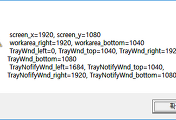1. 대화상자 속성 중 "Absolute Align" True 설정해두고,
2. SetWindowPos 함수 호출하여 좌표지정.
- 함수 호출예 : SetWindowPos(NULL, 100, 200, 0, 0, SWP_NOSIZE); // x좌표 100, y좌표 200 에 출력하라.
- 이때 좌표란 주모니터의 좌상단 을 (0,0) 으로하는 화면 좌표 기준이며, 해당 좌표에 대화상자의 좌상단 꼭지점이 배치된다.
- 함수 인자 중에 SWP_NOSIZE는 윈도우 크기는 변경하지 않는다는 설정이므로, 함수인자 중 width와 height 는 0으로 해도 됨.
3. 대화상자 실행초기 위치 지정하려면 OnInitDialog 내에서 SetWindowPos 함수 호출.
대화상자 실행이후 SetWindowPos 호출해도 지정된 좌표로 즉시 이동.
CWnd::SetWindowPos
Changes the size, position, and Z-order of child, pop-up, and top-level windows.
BOOL SetWindowPos( const CWnd* pWndInsertAfter, int x, int y, int cx, int cy, UINT nFlags );
- pWndInsertAfter
Identifies the CWnd object that will precede (be higher than) this CWnd object in the Z-order. This parameter can be a pointer to a CWnd or a Pointer to one of the following values:
wndBottom Places the window at the bottom of the Z-order. If this CWnd is a topmost window, the window loses its topmost status; the system places the window at the bottom of all other windows.
wndTop Places the window at the top of the Z-order.
wndTopMost Places the window above all non-topmost windows. The window maintains its topmost position even when it is deactivated.
wndNoTopMost Repositions the window to the top of all non-topmost windows (that is, behind all topmost windows). This flag has no effect if the window is already a non-topmost window.
For rules about how to use this parameter, see the "Remarks" section of this topic.
- x
Specifies the new position of the left side of the window.
- y
Specifies the new position of the top of the window.
- cx
Specifies the new width of the window.
- cy
Specifies the new height of the window.
- nFlags
Specifies sizing and positioning options. This parameter can be a combination of the following flags:
SWP_DRAWFRAME Draws a frame (defined when the window was created) around the window.
SWP_FRAMECHANGED Sends a WM_NCCALCSIZE message to the window, even if the window's size is not being changed. If this flag is not specified, WM_NCCALCSIZE is sent only when the window's size is being changed.
SWP_HIDEWINDOW Hides the window.
SWP_NOACTIVATE Does not activate the window. If this flag is not set, the window is activated and moved to the top of either the topmost or the non-topmost group (depending on the setting of the pWndInsertAfter parameter).
SWP_NOCOPYBITS Discards the entire contents of the client area. If this flag is not specified, the valid contents of the client area are saved and copied back into the client area after the window is sized or repositioned.
SWP_NOMOVE Retains current position (ignores the x and y parameters).
SWP_NOOWNERZORDER Does not change the owner window's position in the Z-order.
SWP_NOREDRAW Does not redraw changes. If this flag is set, no repainting of any kind occurs. This applies to the client area, the nonclient area (including the title and scroll bars), and any part of the parent window uncovered as a result of the moved window. When this flag is set, the application must explicitly invalidate or redraw any parts of the window and parent window that must be redrawn.
SWP_NOREPOSITION Same as SWP_NOOWNERZORDER.
SWP_NOSENDCHANGING Prevents the window from receiving the WM_WINDOWPOSCHANGING message.
SWP_NOSIZE Retains current size (ignores the cx and cy parameters).
SWP_NOZORDER Retains current ordering (ignores pWndInsertAfter).
SWP_SHOWWINDOW Displays the window.
Windows are ordered on the screen according to their Z-order; the window at the top of the Z-order appears on top of all other windows in the order.
All coordinates for child windows are client coordinates (relative to the upper-left corner of the parent window's client area).
A window can be moved to the top of the Z-order either by setting the pWndInsertAfter parameter to &wndTopMost and ensuring that the SWP_NOZORDER flag is not set or by setting a window's Z-order so that it is above any existing topmost windows. When a non-topmost window is made topmost, its owned windows are also made topmost. Its owners are not changed.
A topmost window is no longer topmost if it is repositioned to the bottom (&wndBottom) of the Z-order or after any non-topmost window. When a topmost window is made non-topmost, all of its owners and its owned windows are also made non-topmost windows.
If neither SWP_NOACTIVATE nor SWP_NOZORDER is specified (that is, when the application requests that a window be simultaneously activated and placed in the specified Z-order), the value specified in pWndInsertAfter is used only in the following circumstances:
Neither &wndTopMost nor &wndNoTopMost is specified in the pWndInsertAfter parameter.
This window is not the active window.
An application cannot activate an inactive window without also bringing it to the top of the Z-order. Applications can change the Z-order of an activated window without restrictions.
A non-topmost window may own a topmost window, but not vice versa. Any window (for example, a dialog box) owned by a topmost window is itself made a topmost window to ensure that all owned windows stay above their owner.
With Windows versions 3.1 and later, windows can be moved to the top of the Z-order and locked there by setting their WS_EX_TOPMOST styles. Such a topmost window maintains its topmost position even when deactivated. For example, selecting the WinHelp Always On Top command makes the Help window topmost, and it then remains visible when you return to your application.
To create a topmost window, call SetWindowPos with the pWndInsertAfter parameter equal to &wndTopMost, or set the WS_EX_TOPMOST style when you create the window.
If the Z-order contains any windows with the WS_EX_TOPMOST style, a window moved with the &wndTopMost value is placed at the top of all non-topmost windows, but below any topmost windows. When an application activates an inactive window without the WS_EX_TOPMOST bit, the window is moved above all non-topmost windows but below any topmost windows.
If SetWindowPos is called when the pWndInsertAfter parameter is &wndBottom and CWnd is a topmost window, the window loses its topmost status (WS_EX_TOPMOST is cleared), and the system places the window at the bottom of the Z-order.
void CMyApp::OnHideApplication() { //m_pMainWnd is the main application window, a member of CMyApp ASSERT_VALID(m_pMainWnd); // hide the application's windows before closing all the documents m_pMainWnd->ShowWindow(SW_HIDE); m_pMainWnd->ShowOwnedPopups(FALSE); // put the window at the bottom of z-order, so it isn't activated m_pMainWnd->SetWindowPos(&CWnd::wndBottom, 0, 0, 0, 0, SWP_NOMOVE|SWP_NOSIZE|SWP_NOACTIVATE); }
///754.
'VisualStudio.C++.C# > 코딩팁,함수활용,단편' 카테고리의 다른 글
| MFC. Slider 컨트롤 사용법. (0) | 2016.05.22 |
|---|---|
| MFC. Radio button control 사용법. (0) | 2016.05.17 |
| VC++. 다중 모니터 , 화면 좌표 기준 . GetWindowRect (0) | 2016.04.20 |
| VC++. 주 모니터 화면 픽셀수.바탕화면 작업영역, 작업표시줄 사이즈 구하기. (0) | 2016.04.20 |
| VC++. 프로젝트 리소스에 비트맵 추가. (0) | 2016.04.19 |






댓글